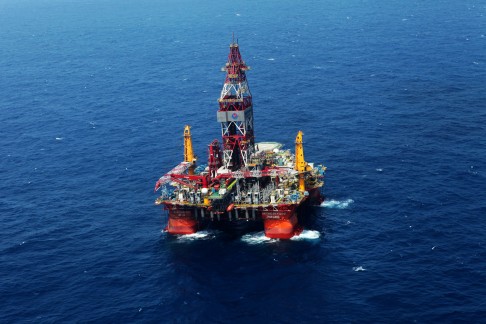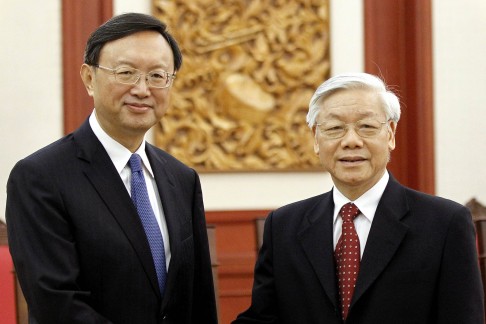But Vietnam’s government is not expected to react strongly as it lies far north to the site of recent clashes
UPDATED : Friday, 20 June, 2014,
Vientnamese protesters chant anti-China slogans in Hanoi, yesterday after China said it was moving a second oil rig closer to Vietnam's coast. Photo: AP
China says it is moving a second oil rig closer to Vietnam’s coast, showing its determination to press its territorial claims and continue searching for resources in disputed waters despite a tense confrontation with Vietnam over another oil rig to the south.
The 600-metre-long rig is being towed southeast of its current position south of Hainan Island and will be in its new location closer to Vietnam by today, the Maritime Safety Administration said on its website. It asked vessels in the area to give it a wide berth.
Vietnam’s government is not expected to react strongly to the placement of the second rig because it lies far to the north of the politically sensitive waters surrounding the Paracel Islands, where ships from the two countries have been ramming each other for more than 40 days near the first oil rig.
China already has three oil rigs in the South China Sea which are reportedly being moved to new locations. Their presence highlights how Beijing has been stepping up its exploration for oil and gas in the tense region.
According to coordinates posted on the website of China’s Maritime Safety Administration, the Nanhai number 2 and 5 rigs will be in southern China and the Pratas islands, which are occupied by Taiwan. The Nanhai 4 rig is close to the Chinese coast.
The increase in oil rigs will inevitably jab a sensitive nerve for Vietnam and the Philippines,
The agency, which did not say who owns the rigs, said all three would be in place by August 12. Moving such rigs is standard practice for the platforms which have been operating for years.
Earlier this week, the agency gave coordinates for the fourth rig, the Nanhai 9, which would be positioned just outside Vietnam’s exclusive economic zone by today.
The Global Times, a popular tabloid published by the Communist Party’s official People’s Daily, quoted Zhuang Guotu, director of the Centre for Southeast Asian Studies at Xiamen University, as calling the rig deployment a "strategic move".
"The increase in oil rigs will inevitably jab a sensitive nerve for Vietnam and the Philippines," Zhuang said.
China’s state oil behemoth CNOOC has said it had four new projects scheduled to come onstream in the western and eastern South China Sea in the second half of 2014.
It was unclear if the four rigs were part of those projects. A CNOOC spokesman declined to comment, but the company has long said that in a bid to boost production it wanted to explore in deeper waters off China.
CNOOC has said it would increase by up to a third its annual capital spending for 2014 to almost US$20 billion.
Protest in Vietnam
A Vietnamese Foreign Ministry official who spoke on normal condition of anonymity said Hanoi believes that no country should take unilateral action in contested waters, but that China has explored the area previously without causing a crisis in relations.
Vietnamese authorities broke up a small protest against the Chinese move yesterday. About a dozen people gathered at a park in central Hanoi and chanted slogans such as “Down with Chinese aggression” for several minutes before being dispersed. At least two protesters were taken away.
The shifting of the rig came as officials from both sides said they made no progress in talks on Wednesday over the deployment of the other Chinese rig on May 1 that sparked the current standoff.
Each country claims the Paracels as its territory and accuses the other of instigating the ship rammings around the rig.
The first rig’s deployment triggered anti-China demonstrations across Vietnam that led to attacks on hundreds of factories believed to employ Chinese workers, five of whom were killed and hundreds more injured. Many of the factories were built and run by investors from Taiwan, which has nothing to do with the current dispute.
China’s military expelled Vietnamese troops from two of the islands in the group in 1974, and in 1988 used force to kick Vietnam out of Johnson South reef in the Spratly Islands to the east.
The border between China and Vietnam in the area of the second rig near the mouth of the Tonkin Gulf has never been properly demarcated, despite five rounds of talks on the matter.
China claims virtually all of the South China Sea, which is rich in natural resources and crisscrossed by some of the world’s busiest sea lanes. That has brought it into dispute with other neighbours, including the Philippines, a US ally.
Vietnam and China held talks this week supposedly to help ease tensions over ship clashes near the Paracels and the first oil rig, platform 981. It had been operating 330 kilometres east of Vietnam and 370km from the southern coast of mainland island Hainan.
However, in a sign that the talks might make little progress, China's State Councillor Yang Jiechi told Hanoi to stop "hyping up" tensions over the oil rig.
It was the highest-level talks between the two countries since the oil rig deployment early last month caused a nosedive in relations.
The discussions were seen as an attempt to contain the worst diplomatic crisis between the ideological allies in decades. But analysts said Yang's sharp remarks indicated no progress was made during the one-day trip.
During a meeting with Yang, Vietnamese Prime Minister Nguyen Tan Dung urged China to withdraw the rig Haiyang 981 and told Yang that China's behaviour severely violated Vietnam's sovereignty and offended the Vietnamese people, according to the state-run Vietnam News Agency.
But in another meeting with Vietnamese Deputy Prime Minister and Foreign Minister Pham Binh Minh, Yang reiterated that oil rig 981 had been operating within an area of Chinese sovereignty
Yang said the current difficulty in the bilateral relationship was a result of Vietnam's "illegal disruptions", according to a summary of the meeting posted on the Chinese foreign ministry's website.
With additional reporting from Kristine Kwok and Reuters




4 comments:
china suppose to put their oil rig on their territory .
It was her territory, Yiekcong can only cry, Chinese will drill Yiekcong behind if she wants too-Goes China goes!...
Anon 1:19
China is not an honorable country. Never has Communism been welcomed in most countries. When you look at China? You can see why Communism is despised.
China even machine gunned, their students down. That is still seen as a disgrace, around the world.
In decent countries, Communist China is very offensive to them. China was very stupid and fouled and polluted their country. Now, China can't even feed their own people. So, China now has to take other countries territories because, their country is a polluted wasteland.
from above poster ''China is not an honorable country. Never has Communism been welcomed in most countries. When you look at China? You can see why Communism is despised.''
don't worry the USA is on its way to being a communist country too...people are being spied on just like in the communist country; those who spoke up against the government are now branded domestic terrorists ; they have set up FEMA to hold people indefinitely without any charge or trial as required by the constitution [ new law signed by Obama called NDAA ], they try to confiscate guns from people so there is no RESISTANCE by using/inciting certain crazy on drug individual to go out shooting public---- and YOU dear poster don't have anything to worry about because you are too blind to see it even though it is right in front of you.
Post a Comment